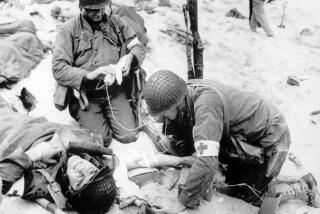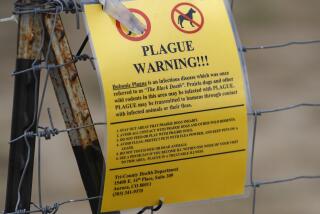200 Years Ago, Plague Spurred Modern Medicine : Health: The 1793 outbreak of yellow fever in Philadelphia had a profound effect on medicine, politics and literature. It led to the creation of public health departments, quarantines and public water systems.
PHILADELPHIA — The first deaths came in July, but the pattern wasn’t clear for another month. Black vomit, yellow skin, frequent nosebleeds and delirium were the symptoms.
On Aug. 19, 1793, Dr. Benjamin Rush, a signer of the Declaration of Independence and one of the leading physicians in what was then the nation’s capital, finally diagnosed this plague: It was yellow fever.
“You can not immagin the situation of this City . . . ,” Isaac Heston, a 23-year-old law clerk, wrote to his brother a month later. “They are aDieing on our right hand & on our left.” Soon he, too, was gone.
Rush’s medicine chest and Heston’s idiosyncratic spelling are among the relics of an epidemic that took 5,000 lives, 10% of the city’s population, before November’s frosts.
This was the young nation’s first major epidemic, and it led to creation of public health departments and procedures for moving the federal government in times of crisis. Its effects were devastating.
“Philadelphia was a shambles,” J. H. Powell wrote in “Bring Out Your Dead,” a 1949 history reissued by the University of Pennsylvania Press.
The federal and state governments shut down. So did four of the five daily newspapers. Mail delivery stopped.
“People who could afford to leave the city left,” said Joanne Blacoe, interpretive specialist for Independence National Historical Park. “Poor people, people of color, stayed.”
Freed blacks led by religious pioneers Absalom Jones and Richard Allen nursed the sick and buried the dead, under the mistaken belief that blacks were immune. Epidemic chronicler Matthew Carey later would accuse blacks of exploiting the diseased and the dying for personal gain.
“That there were some few black people guilty of plundering the distressed, we acknowledge; but in that they only are pointed out, and made mention of, we esteem partial and injurious,” Jones and Allen wrote in a 1794 rebuttal. “We know as many whites who were guilty of it; but this is looked over, while the blacks are held up to censure.”
The Guardians of the Poor, an indigent-care agency incorporated during Colonial times, sought quarters for stricken paupers. Agency members seized an amphitheater used for the nation’s first circus. Neighborhood residents threatened to burn it unless the paupers were removed.
The agency then seized Bush Hill, an empty mansion owned by a man in England, and turned it into a hospital. It became “a dread charnel house of fear, dismal suffering and death,” Powell wrote.
Dr. Jean Deveze, a French doctor who had worked in Santo Domingo, was put in charge of Bush Hill after a period of turmoil.
While Rush advocated strong laxatives and enormous amounts of bleeding, Deveze said anyone who would force nature in such a way “is a scourge more fatal to the human kind than the plague itself would be.”
Deveze’s “French cure” used stimulants and quinine and is somewhat similar to today’s treatments for yellow fever.
People also soaked cloth in vinegar, carried twists of tobacco, fired rifles and smoked cigars, hoping the odors would overpower the “putrid miasma,” or bad air, that was thought to cause the disease.
In fact, it wasn’t until 1900 that Walter Reed proved that yellow fever was caused by a virus spread by mosquitoes. Ironically, some of the popular 18th-Century remedies may have helped.
“Each of these things will keep mosquitoes away from you,” said Laura Beardsley, an interpretive specialist at Independence Park, which offers walking tours, exhibits and talks on yellow fever.
The creation of quarantines, public water systems and orphanages all were spurred to varying degrees by the yellow fever epidemic, said Anna Coxe Toogood, an Independence Park historian.
Baltimore is marking the bicentennial of its Health Department, which began with the appointment of health officers to stop the introduction of yellow fever at the port and the roads from Philadelphia.
Uncertainty about the safety of Philadelphia prompted proposals to move Congress, but no constitutional power existed to do so. Congress later granted the power to the President and the capital was transferred to Trenton, N.J., briefly in 1798 and 1799.
Yellow fever had visited Philadelphia in 1699 and 1762 and returned every year from 1794 to 1799 and many times during the 19th Century. Epidemics also occurred in Boston; New York; Baltimore; Mobile, Ala.; and Memphis, Tenn.
An estimated 100,000 Americans died of yellow fever from 1793 through the end of the 19th Century, according to Dick Levinson, spokesman for the National Museum of Health and Medicine in Washington. The last yellow fever outbreak in this country occurred in New Orleans in 1905.
The death toll was sometimes higher--7,800 in New Orleans in 1853, and 9,200 in New Orleans and Memphis in 1878--but the 1793 outbreak in Philadelphia had a profound effect on medicine, politics and literature.
“Because it was the nation’s capital, it was the first really alarming epidemic,” Toogood said. “So many of the prestigious people, the President and his Cabinet, were all affected.”
More to Read
Sign up for Essential California
The most important California stories and recommendations in your inbox every morning.
You may occasionally receive promotional content from the Los Angeles Times.










